$MYRIAD TOKENS, INFRASCTRUCTURE AND ROADMAP

So, in order to incentivize the rapid growth of the network myriad starts with a pool of Myriad tokens, which are distributed to users in certain cases, the major way Mira is distributed, is when a user has given tips to a social media profile but does not yet exist on myriad, which later joins myriad to claimants tips.
Users who tip the account that joins, who are responsible for that account joining will receive a portion of myriad tokens for that service. We also incentivize the importing of content hosted on other networks to Myriad, both by rewarding users for importing it and giving them hard, an extra reward when they collect tips on it. And of course, like most networks, users can increase their reward of myriad tokens, by running a node on a federated network server for the network.
So just to be very very clear about how that works. You can send a tip on myriad in any cryptocurrency any token supported by the platform to a user who's not on the platform to somebody's Facebook account to somebody's Twitter feed. And if that person actually joins the myriad platform to collect the tips that have been sent to them there, then the users who tip them are going to be rewarded with Myriad token. And this kind of stimulates the network effect to actually bring more and more content creators onto the myriad platform directly.
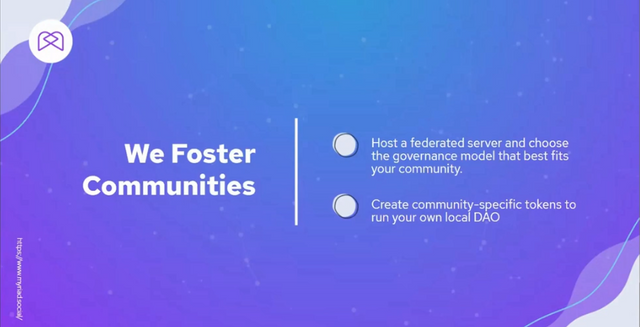
Social media platforms like Facebook, for example, will let people create communities with their own admins and moderators, but these communities have a kind of dual sovereignty, where the content in the groups must be bought. Must be both acceptable to the community's chosen moderators and also acceptable to the platform operators as a whole.
Myriad leaves community hosting with federated nodes, run by members of the public who have the choice over what kind of communities they will host. And while the community is hosted its moderation is subject to a democratic process between the owners of the token representing that community, which are instantiated as a DAO. In this way, people stay in control of what they want to host and how they want their communities run, and are not subject to the dual sovereignty problem with a global platform owner.
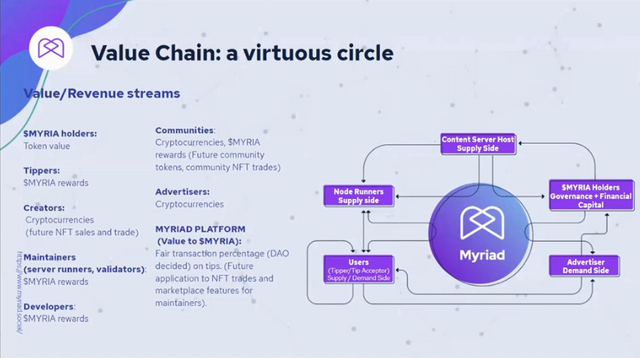
Advertisers created demand for the Myriad token, because it is needed to run their ads on the platform, and users create a general demand from area tokens by needing it to have an influence over the operation of the platforms DAO, and also of the community DAOs that they can own, which then controls and the platforms now specifically controls the investment of financial capital into other development efforts and projects.
So there's a lot of influence to be had when somebody possesses, enough of this token to take an influence in the DAO that runs the platform. In the first phase of myriad users will acquire myriad token by tipping social media persons that do eventually join myriad and node operators acquire some amount of myriad by operating nodes in later phases, once this initial pool of myriad is depleted, the demand for myriad tokens to run advertisements and exercise influence over the DAO will need to be served, entirely by the fixed circulating supply.
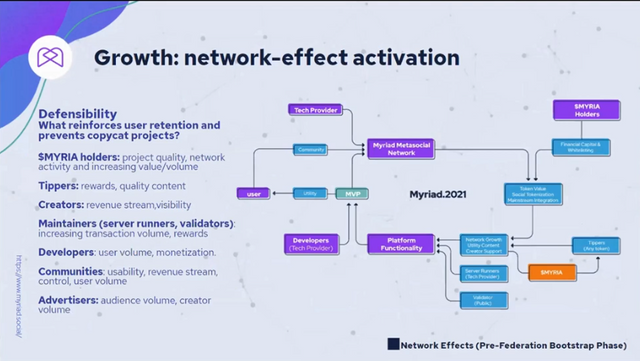
When everything is open, open source code, open smart contracts, open to anyone running a federation, open to anyone creating an experience, a valid question is
what keeps users on our deployment of the myriad platform
Myriads incentive scheme to bring users on the platform, combined with the ease of onboarding by importing content from other social medias, will lead to a rapid onboarding of users that quickly leads to a network effect, it will be difficult for other clones to catch up with. So, for the
- myriad token holders. We have the quality of a project is quite high, the network activity is going to be increasing. And it's going to be increasing in value and volume, so it's going to be difficult for them to make the decision to leave or make their own clone,
- tippers have rewards and quality content to focus on, the creators gain a new revenue stream, and they gain visibility from the people who are there,
- then maintainers, who are the server operators or the validators have an increased transaction volume from people using the platform.
- The developers have a user volume. So the work that they're doing is really being used by a lot of people and that creates opportunities for monetization,
- communities : we focus on the usability and freedom, and the revenue streams obviously that they're able to create and the user volume that will be accessible there.
- And the advertisers, so the audience volume is the creator volume, create a lot of content that can be advertised on which is valuable. So, taken together, these are the ways that we think that network growth is going to seal in myriad network once it actually gets started as kind of the deployment of the myriad network.
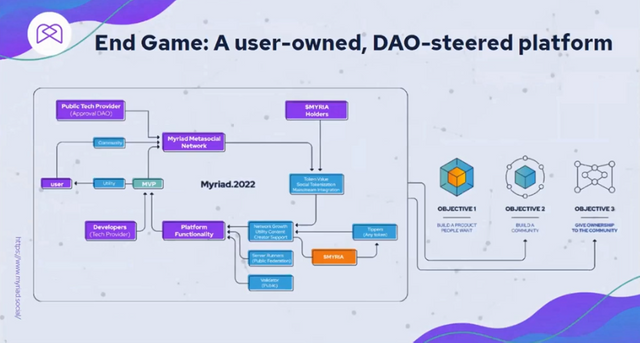
So, while the first line of defence against the mismatched incentives that arise between network operators and normal users is the Federation of public operated myriad servers and individual DAO controlled user communities. There must necessarily still be a global direction and development strategy for the entire myriad platform. The second line of defence against centralised control and the later phases of myriad platform is therefore a DAO, which allows the users to directly own and control the global properties, the network and steer the funding and direction of future developments of the platform.
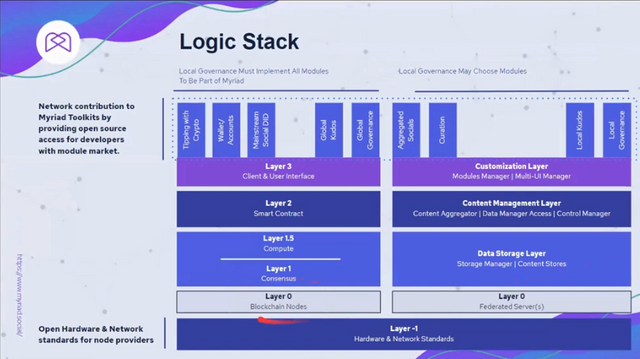
In terms of infrastructure, we can go over briefly our stack is divided into two main categories, which are the blockchain, and the federated servers.
So myriad node consists of least of a blockchain node, and can optionally also host a fun node and the federated network or what we call a federated server, although those can also be hosted separately. So the blockchain layer that powers myriad provides the connection between the myriad nodes and the infrastructure behind the business processes and myriad that require blockchain interaction, so these are especially things like tipping of cryptocurrency high user wallets, user identity, a global reputation scoring and global governance are all handled in the blockchain layer of the application.
But blockchains are well known to have difficulty scaling to the kind of user volume that exists in social media, and so on top of this, we also have a layer of federated servers, which interact with the blockchain lab. The server in infrastructure hosts federated data from certain topics, experiences and communities. This consists of data storage content management and allows for developers to build custom user interface for their own social media applications.
So these are used for aggregating social media content from different platforms onto myriad for content creation, like presenting what's going to go into a feed and operating the algorithms that users choose to organise their feed by, and any kind of local reputation, and local governance. And this is particularly important for the reason of data sovereignty, so blockchain, everybody has to host identical content if you run a node you're hosting exactly the same content as everyone else.
Whereas in social media. Some people believe in certain kinds of speech, and other people don't believe in certain kinds of speech. So, this federated layer of servers allows individual people who believe in a certain kind of speech to volunteer their own resources to host that speech, and the other federated server operators are not necessarily obligated to do this. While we still use the backbone of a blockchain to organise the cryptocurrency, the identities, and all those things that actually make it cohesive.
So the modules that are on the global level must be implemented by local governance, and later on local governments can help extend modules to each local governance, this just means that there's a local governance within federated servers and communities, and this eventually can be built up into a kind of a global governance that manages the entire platform in a decentralised way.
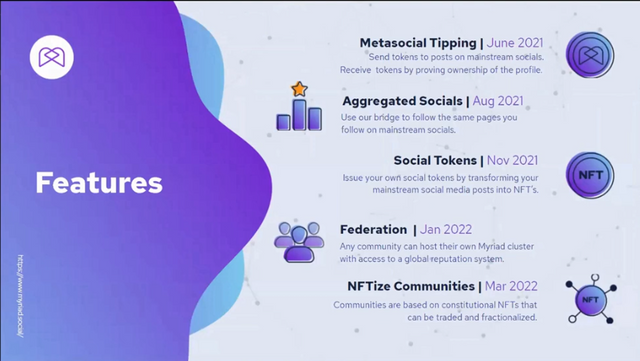
So, based on these comments, this kind of philosophy that we've laid out. Let's look at the roadmap for the next things that we're actually doing in Myriad.
So first, in June 2021 were deploying meta social tipping. So this means that anytime, any user on the myriad platform can send tokens to tip accounts on Myriad. And those tips are going to be, say you can send them to users on Myriad in which case they own them directly, or you can send tips to social media content creators who are not on myriad yet. And those tips will be held in escrow by the platform by a smart contract, waiting for that account to prove ownership of a myriad account, so somebody. If, say if we send a tip to Elon Musk, and then that's gonna accumulate in a smart contract of Escrow tips for you and Musk. If you Elon Musk creates a Myriad account he can prove ownership of his account in a decentralised way he doesn't have to enter his password or anything. And then he'll claim the tips that people distributed. Have you ever been to his account, and also all the people who took to him and got him to join are going to be rewarded with Myriad tokens so they have an incentive as well.
Then coming up in August 2021. We are going to have our aggregated social media experience. So this means a user browsing the myriad platform is going to be able to pull in posts automatically from Twitter from Facebook, from Reddit from all these different platforms, and make myriad kind of the lens that they watch social media through. So, the platform, the federated servers are going to pull in all these different social media posts, users are going to be able to organise them by topic that they're interested in, or the people that they're interested in, and they're also going to be able to choose the proper business algorithms that they want to see these things filtered by to make sure that nobody is in the middle, deciding what they're gonna see and what they're not gonna see.
- By November 21 We want to have social tokens, so a social token is very cool idea that you can take a social media post and turn it into an NFT, and actually sell the NFT, or put it on a marketplace somewhere. So this is especially powerful in the age that social media posts frequently go viral and ownership of a post that happened to go viral, might be very positive, you know, very powerful thing very valuable people might want to collect viral tweets or something like that.
- By January of 2022, we expect to have our federation going. So at this point, any community can host their own myriad cluster with access to the global reputation system, and they can basically any person who wants will be able to host myriad server, so there's no central company no central party involved in deciding, you know how this stuff runs, anybody who has any views on what kind of social media at speech can be hosted can go and host their own federated server,
- and then coming up in March of 2022 to one of our very big, grand goals is the ability to NFTize communities. So this means that when users create a community that runs on one or more federated servers of the platform, those users can actually create a DAO, that's run on the blockchain, that governs the community so governance, including who the administrators are who the moderators are what the rules of posting are the rules of content, what kinds of algorithms are used in the community like all of these different kinds of rules that can be applied to a community can be managed by a DAO, which is collectively, operated by say the owners of that community people who bought the token of that community. So our community can have a token that's used to democratically regulate how the community actually behaves. And so that's kind of where we're going in terms of the roadmap for these different features we want to put in the Myriad platform.
Learn More
Myriad Social
Telegram
Medium